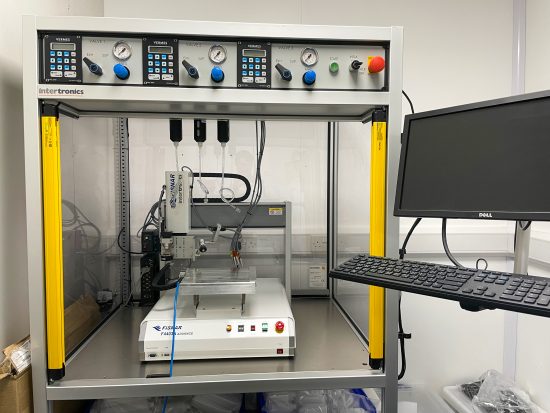To improve the accuracy, repeatability, and manufacturing speed of their key product line Kemio™, a water testing system utilising patented single-use sensor technology, Palintest came to us. Using electrochemical sensors, the product tests the concentration of chlorine, chlorine dioxide, chlorite or peracetic acid in samples, giving a clear pass or fail mark in 60 seconds.
Initially the manufacturing process included manually dispensing reagent onto sensors. Palintest invested in an automated system that was based on a jetting dispensing valve to improve accuracy, repeatability, and throughput. However, Palintest was experiencing problems with corrosion with the new valve. Following research, Palintest reached out to us for help. Working closely with Palintest, we customised and installed a VERMES MDS 3020+ Microdispensing Valve that optimised the dispensing process and with no corrosion. To enable easier transition into production for new products, we then built a development machine that replicated Palintest’s updated production process, combining the VERMES valve with a Fisnar dispensing robot and vision system.

Development system replicates production process
“Anything in the material path had to be compatible with Palintest’s reagents,” explained Paul Whitehead, Strategic Accounts Manager at Intertronics. “We recommended a valve with a ceramic tappet combined with coated carbide tips. Trials found that this combination did not react with the reagents and there was no corrosion.”
“Intertronics were extremely receptive to what we needed, and from first contact it was clear they were willing to come on the journey with us,” explained Samantha Lunn, Sensor Development Manager at Palintest.
“Our new automated system has enabled huge growth in our manufacturing output, we can produce up to 24,000 sensors each day, compared with under 10,000 on the previous line,” added Matthew Hentley-Richold, Production Manager at Palintest. “We’ve increased our stock levels, meaning we can fulfil customer orders faster , and scope out future expansion in our operations with a possible second production line.”
You can read the full case study here: Improving accuracy, repeatability, and speed using jet dispensing
Categories: case study, dispensing, productivity, robotics
